[English] 日本語
 Yorodumi
Yorodumi- PDB-4m7e: Structural insight into BL-induced activation of the BRI1-BAK1 complex -
+ Open data
Open data
- Basic information
Basic information
| Entry | Database: PDB / ID: 4m7e | |||||||||
|---|---|---|---|---|---|---|---|---|---|---|
| Title | Structural insight into BL-induced activation of the BRI1-BAK1 complex | |||||||||
 Components Components |
| |||||||||
 Keywords Keywords | TRANSFERASE / phytohormone / brassinosteroid-insensitive 1 / leucine-rich repeat / receptor-like kinases | |||||||||
| Function / homology |  Function and homology information Function and homology informationdetection of brassinosteroid stimulus / brassinosteroid homeostasis / anther wall tapetum cell differentiation / pollen exine formation / positive regulation of flower development / seedling development / brassinosteroid mediated signaling pathway / leaf development / receptor serine/threonine kinase binding / response to UV-B ...detection of brassinosteroid stimulus / brassinosteroid homeostasis / anther wall tapetum cell differentiation / pollen exine formation / positive regulation of flower development / seedling development / brassinosteroid mediated signaling pathway / leaf development / receptor serine/threonine kinase binding / response to UV-B / steroid binding / transmembrane receptor protein tyrosine kinase activity / defense response / receptor protein-tyrosine kinase / non-specific serine/threonine protein kinase / protein kinase activity / endosome / endosome membrane / protein heterodimerization activity / signaling receptor binding / protein serine kinase activity / protein serine/threonine kinase activity / protein homodimerization activity / protein-containing complex / ATP binding / identical protein binding / plasma membrane Similarity search - Function | |||||||||
| Biological species |  | |||||||||
| Method |  X-RAY DIFFRACTION / X-RAY DIFFRACTION /  SYNCHROTRON / SYNCHROTRON /  MOLECULAR REPLACEMENT / Resolution: 3.602 Å MOLECULAR REPLACEMENT / Resolution: 3.602 Å | |||||||||
 Authors Authors | Chai, J. / Han, Z. / Sun, Y. | |||||||||
 Citation Citation |  Journal: To be Published Journal: To be PublishedTitle: Structural insight into BL-induced activation of the BRI1-BAK1 complex Authors: Sun, Y. / Han, Z. / Chai, J. | |||||||||
| History |
|
- Structure visualization
Structure visualization
| Structure viewer | Molecule:  Molmil Molmil Jmol/JSmol Jmol/JSmol |
|---|
- Downloads & links
Downloads & links
- Download
Download
| PDBx/mmCIF format |  4m7e.cif.gz 4m7e.cif.gz | 352.6 KB | Display |  PDBx/mmCIF format PDBx/mmCIF format |
|---|---|---|---|---|
| PDB format |  pdb4m7e.ent.gz pdb4m7e.ent.gz | 283.6 KB | Display |  PDB format PDB format |
| PDBx/mmJSON format |  4m7e.json.gz 4m7e.json.gz | Tree view |  PDBx/mmJSON format PDBx/mmJSON format | |
| Others |  Other downloads Other downloads |
-Validation report
| Summary document |  4m7e_validation.pdf.gz 4m7e_validation.pdf.gz | 2 MB | Display |  wwPDB validaton report wwPDB validaton report |
|---|---|---|---|---|
| Full document |  4m7e_full_validation.pdf.gz 4m7e_full_validation.pdf.gz | 2.1 MB | Display | |
| Data in XML |  4m7e_validation.xml.gz 4m7e_validation.xml.gz | 74.8 KB | Display | |
| Data in CIF |  4m7e_validation.cif.gz 4m7e_validation.cif.gz | 99.2 KB | Display | |
| Arichive directory |  https://data.pdbj.org/pub/pdb/validation_reports/m7/4m7e https://data.pdbj.org/pub/pdb/validation_reports/m7/4m7e ftp://data.pdbj.org/pub/pdb/validation_reports/m7/4m7e ftp://data.pdbj.org/pub/pdb/validation_reports/m7/4m7e | HTTPS FTP |
-Related structure data
| Related structure data | 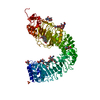 3rgzS S: Starting model for refinement |
|---|---|
| Similar structure data |
- Links
Links
- Assembly
Assembly
| Deposited unit | 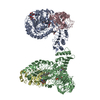
| ||||||||
|---|---|---|---|---|---|---|---|---|---|
| 1 | 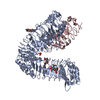
| ||||||||
| 2 | 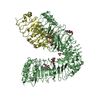
| ||||||||
| Unit cell |
|
- Components
Components
-Protein , 2 types, 4 molecules ABDC
| #1: Protein | Mass: 83048.812 Da / Num. of mol.: 2 / Fragment: UNP RESIDUES 24-785 Source method: isolated from a genetically manipulated source Source: (gene. exp.)  References: UniProt: O22476, receptor protein-tyrosine kinase, non-specific serine/threonine protein kinase #2: Protein | Mass: 21625.393 Da / Num. of mol.: 2 / Fragment: UNP RESIDUES 26-221 Source method: isolated from a genetically manipulated source Source: (gene. exp.)  References: UniProt: Q94F62, receptor protein-tyrosine kinase, non-specific serine/threonine protein kinase |
|---|
-Sugars , 2 types, 7 molecules 
| #3: Polysaccharide | 2-acetamido-2-deoxy-beta-D-glucopyranose-(1-4)-2-acetamido-2-deoxy-beta-D-glucopyranose Source method: isolated from a genetically manipulated source #4: Sugar | |
|---|
-Non-polymers , 2 types, 4 molecules 


| #5: Chemical | | #6: Chemical | |
|---|
-Details
| Has protein modification | Y |
|---|
-Experimental details
-Experiment
| Experiment | Method:  X-RAY DIFFRACTION / Number of used crystals: 1 X-RAY DIFFRACTION / Number of used crystals: 1 |
|---|
- Sample preparation
Sample preparation
| Crystal | Density Matthews: 4.88 Å3/Da / Density % sol: 74.8 % |
|---|---|
| Crystal grow | Temperature: 298 K / Method: evaporation / pH: 4 Details: 0.1M Citric Acid, 2.0M (NH4)2SO4, pH 4.0, EVAPORATION, temperature 298.0K |
-Data collection
| Diffraction | Mean temperature: 298 K |
|---|---|
| Diffraction source | Source:  SYNCHROTRON / Site: SYNCHROTRON / Site:  SSRF SSRF  / Beamline: BL17U / Wavelength: 1 Å / Beamline: BL17U / Wavelength: 1 Å |
| Detector | Type: ADSC QUANTUM 210 / Detector: CCD / Date: Jun 25, 2013 |
| Radiation | Monochromator: SAGITALLY FOCUSED Si(111) / Protocol: SINGLE WAVELENGTH / Monochromatic (M) / Laue (L): M / Scattering type: x-ray |
| Radiation wavelength | Wavelength: 1 Å / Relative weight: 1 |
| Reflection | Resolution: 3.6→50 Å / Num. all: 45864 / Num. obs: 45084 / % possible obs: 98.3 % / Observed criterion σ(F): 2 / Observed criterion σ(I): 1 / Redundancy: 2.6 % / Rsym value: 0.061 |
- Processing
Processing
| Software |
| ||||||||||||||||||||||||||||||||||||||||||||||||||||||||||||||||||||||||||||||||||||||||||||||||||||||
|---|---|---|---|---|---|---|---|---|---|---|---|---|---|---|---|---|---|---|---|---|---|---|---|---|---|---|---|---|---|---|---|---|---|---|---|---|---|---|---|---|---|---|---|---|---|---|---|---|---|---|---|---|---|---|---|---|---|---|---|---|---|---|---|---|---|---|---|---|---|---|---|---|---|---|---|---|---|---|---|---|---|---|---|---|---|---|---|---|---|---|---|---|---|---|---|---|---|---|---|---|---|---|---|
| Refinement | Method to determine structure:  MOLECULAR REPLACEMENT MOLECULAR REPLACEMENTStarting model: 3RGZ Resolution: 3.602→45.904 Å / SU ML: 0.49 / σ(F): 1.97 / Phase error: 33.88 / Stereochemistry target values: ML
| ||||||||||||||||||||||||||||||||||||||||||||||||||||||||||||||||||||||||||||||||||||||||||||||||||||||
| Solvent computation | Shrinkage radii: 0.9 Å / VDW probe radii: 1.11 Å / Solvent model: FLAT BULK SOLVENT MODEL | ||||||||||||||||||||||||||||||||||||||||||||||||||||||||||||||||||||||||||||||||||||||||||||||||||||||
| Refinement step | Cycle: LAST / Resolution: 3.602→45.904 Å
| ||||||||||||||||||||||||||||||||||||||||||||||||||||||||||||||||||||||||||||||||||||||||||||||||||||||
| Refine LS restraints |
| ||||||||||||||||||||||||||||||||||||||||||||||||||||||||||||||||||||||||||||||||||||||||||||||||||||||
| LS refinement shell | Refine-ID: X-RAY DIFFRACTION / Total num. of bins used: 16
|
 Movie
Movie Controller
Controller



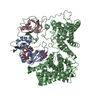
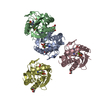
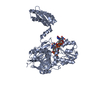
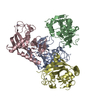

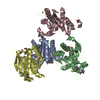
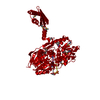
 PDBj
PDBj







